Veterinarians & Pets
| 2016 Q1 | story by EMILY MULLIGAN | photos by STEVEN HERTZOG
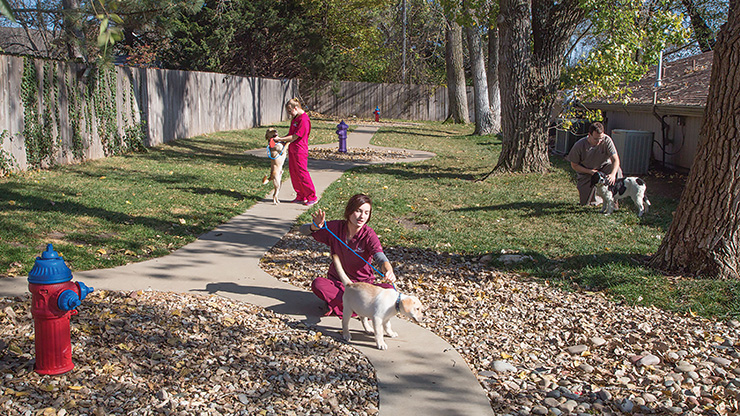
Dog exercise area at Clinton Parkway Animal Hospital
Veterinarians are ultimately scientists, but being the doctor for beloved pets who can’t speak for themselves is a job with many (usually furry) layers. Vets must contend with pet owners’ emotions, their own emotions, scientific data, finances and, of course, somehow relate to every single animal that comes in the door of their clinic.
Tom Liebl does not remember actually deciding to become a veterinarian. That is because his father was a farm vet in western Kansas, and his dad’s job was a family affair that involved the kids and Liebl’s mom cleaning out kennels, and even pulling calves and corralling pigs. Liebl is one of three veterinarians among the four kids in his family, and his own son will graduate from veterinary school this May. Liebl’s clinic at Clinton Parkway Animal Hospital is much more a “city” practice than his dad’s, focused mainly on dogs and cats. After veterinary school at Kansas State University, Liebl joined his brother’s veterinary practice in southern California. Then, after his first child was born, he and his wife decided to move back to Kansas. He took the job in Lawrence thinking he would work here until he found something in Kansas City. “That was 1990, and I’m still here,” he says.
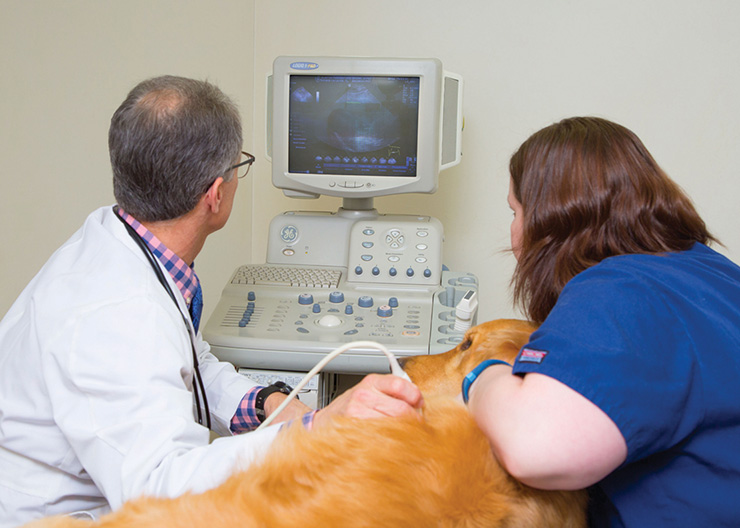
Tom Liebl – Clinton Parkway Animal Hospital
Matthew Coles is a veterinarian at the Animal Hospital of Lawrence. When he was in seventh grade in Oklahoma, he wrote a paper about becoming a vet. Within two years, he was working at a local veterinary office doing cleanup and “grunt work,” and then moved on to another office, where he worked like a veterinary technician, giving injections, developing x-rays and starting IVs. During veterinary school at Oklahoma State University, he worked at a clinic in Overland Park and lived with friends in Lawrence. So when the Animal Hospital was looking for a new vet, his wife encouraged him to apply. Now, 12 years later, he is in the process of buying the business from William Bayouth.
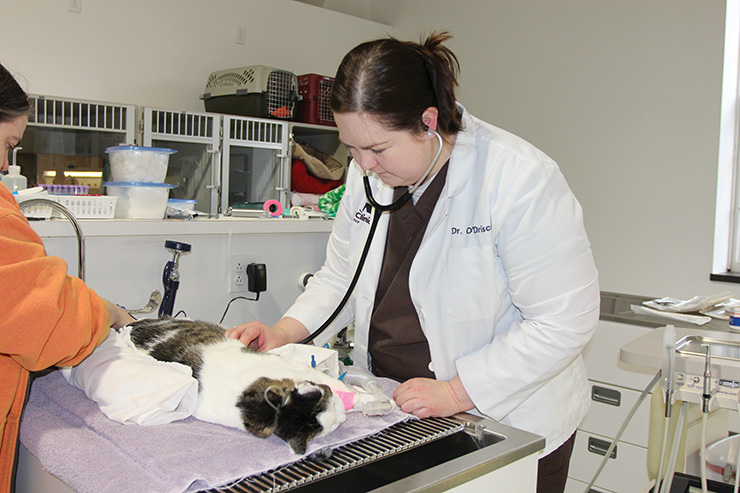
D_r_._ _J_e_n_n_i_f_e_r_ _O_’D_r_i_s_c_o_l_l__ _a_t_ _C_a_t_ _C_l_i_n_i_c_
Jennifer O’Driscoll, owner and veterinarian at The Cat Clinic, was one of those kids who knew she wanted to be a veterinarian from a very young age. She grew up mostly in Dallas and went to veterinary school in Massachusetts, and says she moved to Lawrence “randomly.” But it has been a great fit for her practice that exclusively treats cats. After veterinary school, she did an internship and part of a residency in veterinary neurology before doing both emergency vet work and general practice for dogs and cats. Through her experience, she says she thought that not as much attention was paid to cats’ medical needs in practices that saw both dogs and cats, so she decided to open her own cat-focused clinic in 2011. She says cat behavior, in particular, is interesting to her, and she likes to be able to go in-depth into “cat problems.”
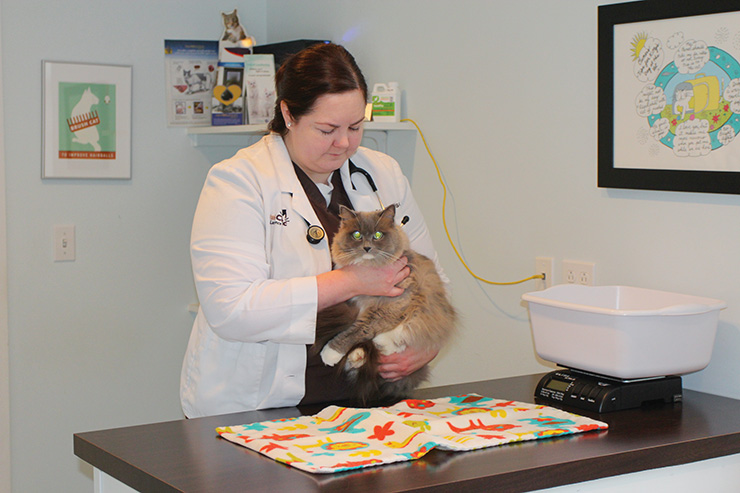
D_r_._ _J_e_n_n_i_f_e_r_ _O_’D_r_i_s_c_o_l_l__ _a_t_ _C_a_t_ _C_l_i_n_i_c_
The bulk of the four years in veterinary school is spent learning the science aspect of veterinary medicine. Even though the animals are usually smaller than humans, their body systems are no less complicated. Add to that the animals cannot speak for themselves, so the vets must use their strong science base and their five senses to assess the patients.
“It does take a high level of attention. We’re looking for clues that are nonverbal clues,” Liebl says. “We see problem after problem that span a multitude of body systems—it could be heart, kidney, orthopedic, behavior, ophthalmology. The majority of us deal in the situation that we have to be all of those on any given day.”
O’Driscoll says that many of cats’ most common physical medical problems actually are caused by mental issues, such as stress from life changes or being alone.
“One of the main differences between cats and dogs is that cats hide illness very well. Often, it has been going on for a while by the time they are showing symptoms,” she says. “Dogs are usually better at showing their people that something is wrong.”
Helping animals is what they do, but the veterinary clinics are still businesses that have to pay bills. And with many medical procedures and tests that are available to humans, such as CT scans and endoscopies, now available to animals, veterinary care can become pretty pricey.
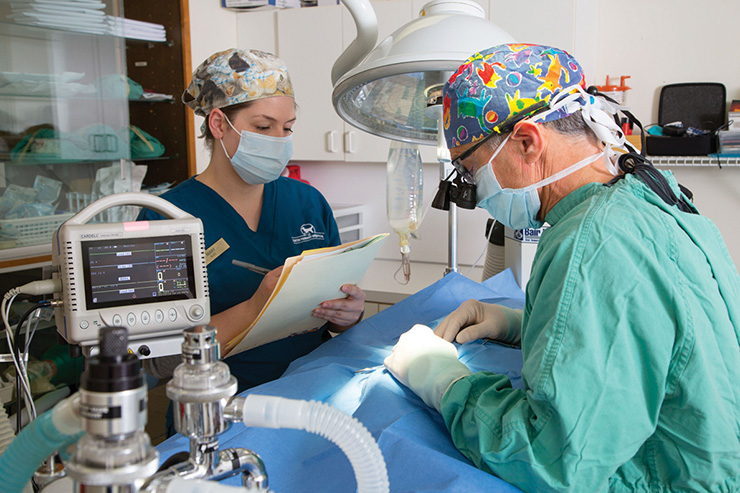
Tom Liebl – Clinton Parkway Animal Hospital
Coles, Liebl and O’Driscoll all agree that balancing pet owners’ finances with diagnoses and treatments is a daily challenge of their work. Coles says he has had to learn to navigate those conversations on the job, because it’s not something that is taught in veterinary school. As much as possible, they all work with the pet owner to find the best, most affordable paths to diagnosis and treatment.
“One of the most difficult conversations to have is for a cat that has an illness or problem that is probably fixable but expensive. It is hard for people to make a decision, and my crystal ball is always broken—I can’t tell the future,” O’Driscoll says.
Finances present their set of challenges for the vets, but the emotional toll can be rough, as well. A 2015 study published in the Journal of the American Veterinary Medical Association says that veterinarians have higher rates of depressive episodes and thoughts of suicide than the national average. It explains that it is likely a combination of personality traits that vets share and the stress of operating a clinical practice that accounts for those higher rates. Regardless, the vets say being in the position of seeing animals suffer and having to make a decision to end their lives is not an easy task.
“There is an emotional toll it starts to take. There is a lot of counseling and hand-holding you have to do,” Coles says.
When it comes time for a pet’s life to end, the veterinarians must console themselves along with the pet owners and the animal.
“I take comfort knowing they’ve had a great life and don’t have to spend the next days, weeks or months suffering.” Liebl says. “It’s one of those honors and duties as vets that we have to take that responsibility seriously. You have to find a place in your heart that it all makes sense.”
The vets agree putting animals down is still difficult and emotional, even when it is clearly the best course of action.
“Being a vet is a very emotional job dealing with people and animals,” O’Driscoll says. “The cats I euthanize, it is always in the best interest of the cat. But it is hard for the owner, even if the cat is sick and not getting better. Cats are around for a long time. I definitely have tried to get better at helping people when their cat passes away.”
There are also happy emotions in being a veterinarian: puppies, kittens and happy families who have found a new friend. So the vets must reconcile all of the emotional extremes.
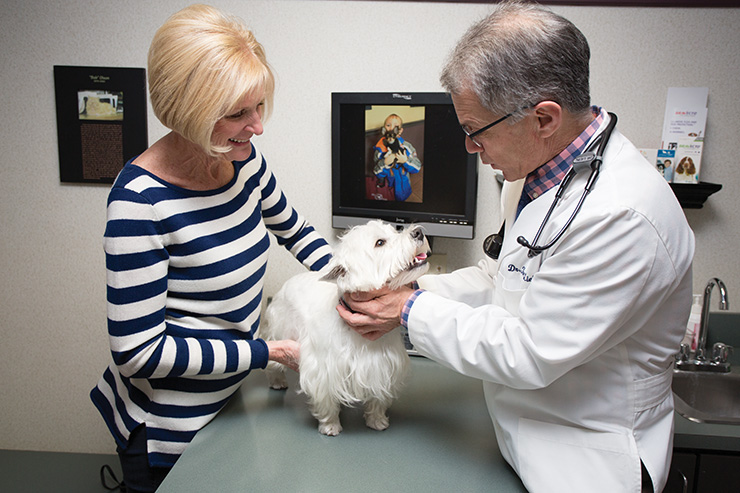
Tom Liebl – Clinton Parkway Animal Hospital
“After you put an animal down, you can’t leave the clinic and take the rest of the day off to go grieve. The next half-hour is someone with a different problem. That’s the hardest part, is the roller coaster all through the day,” Liebl says.
At least half of each day is spent doing checkups, the vets say. But at any moment, an animal with an urgent medical need can come through the door.
“Things change so quickly here that what looks like a boring day can turn hectic in a minute,” Coles says.
Even with emergency veterinary care available late at night and on weekends in Overland Park, the vets have a hard time keeping their work contained to regular hours.
“The career itself is very time-consuming. It’s never going to be 9 to 5,” Liebl says. “It stays with you most of your day. I knew that going in. It’s a lifestyle more than a job.”
Even with just one species at The Cat Clinic, O’Driscoll says the variety in one day can be dizzying. She attempts to illustrate the range:
“I might see a 20-year-old cat that is skinny and has a disease and arthritis, and we need to balance meds for the rest of its life. The next visit might be a 1-year-old cat that ate a string and needs surgery,” she explains. “Then, a 9-week-old kitten is bouncing around the exam room. And then, I see a 7-year-old cat that eats Doritos and too much cat food.”
When pets and their owners come for routine checkups, Coles says he spends a lot of time discussing the most common issues for dogs and cats: dental problems and weight problems. He says pet owners can avoid costly dental procedures by starting early with brushing and giving them dental chews regularly. As for the weight problems, “You’re in complete control of that. Limit food, and give them exercise,” he says.
Liebl explains that similar to the human world, veterinarians are about preventative health care, such as vaccines, nutrition and parasite control. He says the physical exam is the most important part of a vet visit, along with a discussion with the owner about how the animal is doing at home—because, unlike humans, the pets often behave quite differently at the vet’s office than at home.
Despite the “roller coaster” of the day-to-day job and the challenges of dealing with patients that can’t talk, the veterinarians say their work might be some of the most satisfying. And not just because they can help make pets (and their owners) feel better when they’re sick.
“Pets bring a level of enjoyment to everyone. The relationships that this job allows us to have with our clientele, their families and our staff are very rewarding. The intimacy I get to have with families over years of seeing their pet—watching the kids grow up and families evolve—it becomes a partnership thing that I really love,” Liebl says.

3 Comments
each time i used to read smaller articles that also clear their motive, and that is
also happening with this paragraph which I am reading at this time.
I am not sure where you are getting your info, but great topic.
I needs to spend some time learning much more or understanding more.
Thanks for fantastic information I was looking
for this info for my mission.
I’ve learn several good stuff here. Definitely value bookmarking for revisiting.
I surprise how so much effort you set to create this type of excellent
informative web site.